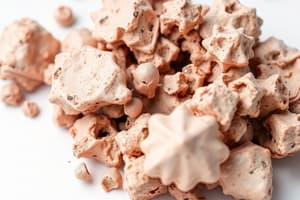Podcast
Questions and Answers
Which type of property does not change with the amount of matter being considered?
Which type of property does not change with the amount of matter being considered?
- Extensive property
- Physical property
- Chemical property
- Intensive property (correct)
If the color of a substance changes, it is an example of a change in its ____________.
If the color of a substance changes, it is an example of a change in its ____________.
- Melting point
- Physical property (correct)
- Hardness
- Boiling point
What property refers to the resistance of a substance to deformation when pressure is applied?
What property refers to the resistance of a substance to deformation when pressure is applied?
- Intensive property
- Boiling point
- Solubility
- Hardness (correct)
The boiling point of a substance is an example of which type of property?
The boiling point of a substance is an example of which type of property?
What type of property is the measure of the average kinetic energy of particles in a substance?
What type of property is the measure of the average kinetic energy of particles in a substance?
Solubility, the ability of a substance to dissolve in another, is an example of a ____________.
Solubility, the ability of a substance to dissolve in another, is an example of a ____________.
Which type of property scales with the amount of matter present in a substance?
Which type of property scales with the amount of matter present in a substance?
What is an example of an extensive property?
What is an example of an extensive property?
Which type of property is associated with the state or condition of matter?
Which type of property is associated with the state or condition of matter?
What does density represent?
What does density represent?
If you double the mass of a substance, which property will also double?
If you double the mass of a substance, which property will also double?
Which property is affected by the quantity of matter, volume, or number of particles in a substance?
Which property is affected by the quantity of matter, volume, or number of particles in a substance?
Flashcards are hidden until you start studying
Study Notes
Exploring Matter's Properties
Matter, the substance all around us, exhibits a wide variety of characteristics. These characteristics, or properties, help us categorize and describe the substances we encounter in our daily lives. In this article, we'll delve into three specific types of properties that are essential to understanding matter: extensive properties, intensive properties, and physical properties.
Extensive Properties
Extensive properties are those that are proportional to the amount of matter in a substance. They depend on the quantity of matter present in a system, scaling with mass, volume, or number of particles. Some examples of extensive properties include:
- Mass: The amount of matter present in an object.
- Volume: The space occupied by a substance.
- Energy: The amount of energy stored or in motion within a system.
- Entropy: A measure of the disorder or randomness in a system.
These properties are extensive because they increase proportionally with the amount of matter being considered. For example, if you double the mass of a substance, the mass of the substance will also double.
Intensive Properties
Intensive properties, on the other hand, do not depend on the amount of matter present in a substance. Instead, they are associated with the state or condition of the matter. Some examples of intensive properties include:
- Density: The mass per unit volume of a substance.
- Pressure: The force per unit area exerted by a substance.
- Temperature: The measure of the average kinetic energy of the particles in a substance.
- Melting point: The temperature at which a substance changes state from solid to liquid.
Intensive properties do not change with the amount of matter being considered. For example, the melting point of water remains constant regardless of the amount of water present.
Physical Properties
Physical properties are attributes of matter that can be observed or measured without altering the substance's chemical identity. They are either extensive or intensive properties. Some examples of physical properties include:
- Color: The appearance of a substance.
- Hardness: The resistance of a substance to deformation when applied pressure is exerted.
- Boiling point: The temperature at which a substance changes state from liquid to gas.
- Solubility: The ability of a substance to dissolve in another substance.
Physical properties are essential for identifying and classifying substances. They are also used in various applications, such as separating mixtures or determining the purity of a substance.
In summary, matter properties encompass extensive properties, intensive properties, and physical properties. These properties help us to understand the behavior of substances and provide tools for classifying, identifying, and manipulating matter. By understanding these properties, we can better appreciate the world around us and make informed decisions in fields as diverse as chemistry, materials science, and environmental management.
Studying That Suits You
Use AI to generate personalized quizzes and flashcards to suit your learning preferences.




